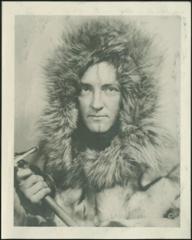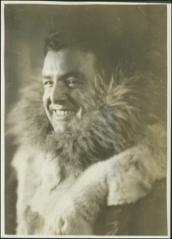Admiral and Engineer: Biographies of Richard E. Byrd and Thomas B. Mulroy
Richard E. Byrd
Richard E. Byrd was born in Winchester, Virginia on October 25, 1888. As a young academic, Byrd attended the Virginia Military Institute, where he was inspired to join the U.S. Naval Academy, beginning his naval career. Eventually, Byrd became a naval aviator, which directed the rest of his career. After the first World War, Byrd was selected for the historic aviation transatlantic crossing of 1919. Later, in 1926, Byrd attempted his first Polar flight. He attempted to fly over the North Pole in a plane named Josephine Ford, funded by his friends Henry Ford and John D. Rockefeller. Yet, there remains controversy over whether the 1926 flight actually reached the North Pole. Nevertheless, Byrd returned as an American hero, earning the Medal of Honor.
Byrd’s first Antarctic Expedition, in 1928, was historic in its use of modern technology such as airplanes, cameras, snowmobiles, and radio communication. The expedition erected a base camp called “Little America” on the Ross Ice Shelf, and led many scientific expeditions. This expedition earned Byrd further recognition, earning him the rank of admiral in the U.S. Navy. Byrd is now known as a pioneer of American and Polar aviation.
Thomas B. Mulroy
Thomas B. Mulroy was born in St. Louis, Missouri in 1896. On both Richard E. Byrd’s 1926 and 1928 expeditions, Mulroy accompanied him as a chief engineer and fuel engineer, remaining crucial to the functioning and success of the Byrd expeditions. Before Mulroy’s second expedition with Richard E. Byrd, his friends bought him a journal to keep track of his thoughts and experiences. Stamped on the front of the journal was “Smiling Tom Mulroy,” above another stamp that read “Byrd Antarctic Expedition.” Mulroy wrote in this journal, keeping track of the distance their ship, the City of New York, had traveled, the discoveries they had made, and the general happenings aboard the ship, from his perspective as an engineer. Much of the diary contained day-to-day descriptions of the weather, the conditions, and the travel, filled with optimism, worry, and frustration, depicting the true human experience on board an Antarctic expedition. Some sections of the diary are crossed out or cleaned up, as Mulroy was potentially under the impression that a journal of the 1928 expedition could be used in the future either by Commander Richard E. Byrd or by the public. Or, perhaps, Mulroy was just reflecting on his earlier words.
“1928-30 Byrd Antarctic Expedition- Chief Engineer Thomas B. Mulroy Diary.” Heritage Auctions, Oct. 2006, historical.ha.com/itm/autographs/celebrities/1928-30-byrd-antarctic-expedition-chief-engineer-thomas-b-mulroy-s-personal-diary-for-august-24-to-december-31-of-the-year/a/629-25507.s.
“Byrd Antarctic Expedition (1st: 1928-1930) : Photo Album 1.” The Ohio State University Libraries Knowledge Bank, May 2007, kb.osu.edu/collections/3bac7625-e3a8-5f33-8305-6f937221a168.
“Richard E. Byrd.” Virginia Museum of History & Culture, virginiahistory.org/learn/richard-e-byrd#:~:text=Some%20experts%20dispute%20that%20Byrd,Lone%20Eagle%22%20like%20Charles%20Lindbergh. Accessed 19 Nov. 2024.
“Richard E. Byrd.” Wikipedia, Wikimedia Foundation, 19 Nov. 2024, en.wikipedia.org/wiki/Richard_E._Byrd.


